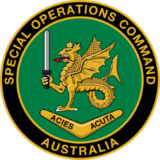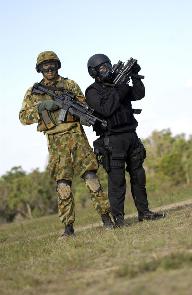Special Operations Command (Australia)
| Special Operations Command | |
|---|---|
 | |
| Active | 2003–present |
| Country | Australia |
| Role | Special operations |
| Size | 2,050 (active in 2014)[1] 750 (reserve in 2014)[1] |
| Part of | Australian Defence Force |
| Headquarters location | General John Baker Complex, Bungendore[2] |
| Motto(s) | Acies Acuta (The Cutting Edge) |
| Commanders | |
| Current commander | Major General Garth Gould |
The Special Operations Command (SOCOMD) is an Australian Defence Force command that was established on 5 May 2003 to unite all of the Australian Army's special forces units and by 2008 was fully operational.[3][4][5] Australia's Special Operations Command is of equivalent status to Australia's Fleet, Forces and Air Commands.[3] It is modelled on the equivalent commands in the United States and British military forces, and is led by a major general as Special Operations Commander Australia (SOCAUST).
The origins of SOCOMD began in 1979 with the army creating a small Directorate Special Action Forces—Army. On 13 February 1990, Headquarters Special Forces was established, which was renamed in 1997 to Headquarters Special Operations and in 2003 to Special Operations Headquarters or SOCOMD.[5][6][7]
History
[edit]
- East Timor (May 2006 – 2007)
- Security for the 2006 Commonwealth Games in Melbourne (March 2006)
- Afghanistan (2001–02) (2005–06) (2007–2021)[8]
- Iraq (2003–09) (2014–)
- Security for the 2003 Rugby World Cup (October – November 2003)
- Security for President George W. Bush's visit to Canberra (October 2003)
While Special Operations Command had not formally commenced operations at the time, it appears that the headquarters may have overseen the boarding of the North Korean freighter MV Pong Su in April 2003, which involved elements of both the Special Air Service Regiment and 4th Battalion, Royal Australian Regiment (Commando) Tactical Assault Groups.[9]
In November 2018, the 30th Asia-Pacific Economic Cooperation (APEC) meeting held in Port Moresby in Papua New Guinea had Special Operations Command involvement to enhance the Papua New Guinea Defence Force's Incident Response Group to provide security as world leaders, including Scott Morrison, Mike Pence, Xi Jinping, Dmitry Medvedev and other government and economic leaders were in attendance.[10][11] The Incident Response Group had received extensive training to build its capabilities in preparation for the meeting from SOCOMD units and the New Zealand Special Operations Component Command.[12]
Organisation
[edit]
As of 2020, the Special Operations Command comprised the following units:[13]
- Headquarters, Special Operations Command Headquarters (SOHQ) (GJBC and Russell Offices)[14][2]
- Headquarters, Special Forces Group[15]
- Special Air Service Regiment (Swanbourne, WA)
Incorporates the role of Tactical Assault Group (West).- 1 Squadron
- 2 Squadron
- 3 Squadron
- 4 Squadron
- 152 Signals Squadron
- Specialist Support Squadron
- Operational Support Squadron
- 1st Commando Regiment a mixed Regular Army and Army Reserve Unit
- Regimental Headquarters (Randwick Barracks, Sydney)
- 1 Commando Company (HMAS Penguin, Sydney)
- 2 Commando Company (Williamstown, VIC)
- 301 Signals Squadron (Randwick Barracks, Sydney with elements in the commando companies)
- 2nd Commando Regiment (Holsworthy, NSW)
Incorporates the role of Tactical Assault Group (East).- A Company
- B Company
- C Company
- D Company
- 126 Signals Squadron
- Operations Support Company
- Logistics Support Company
- Special Operations Engineer Regiment (Holsworthy, NSW)
- A Squadron
- B Squadron
- Logistic Support Troop
- Special Operations Logistics Squadron (Holsworthy, NSW)
- Defence Special Operations Training and Education Centre (Holsworthy, NSW)[16]
- Special Air Service Regiment (Swanbourne, WA)
- Headquarters, Special Forces Group[15]
Special Operations Commander Australia (SOCAUST)
[edit]The Special Operations Commander Australia (SOCAUST) is responsible for the peacetime 'raise, train and sustain' functions of Special Operations Command reporting to the Chief of Army, while the Chief of Joint Operations is responsible for the operational functions of Special Operations Command deployments.[7] The SOCAUST is responsible for the domestic counter-terrorism deployments of Special Operations Command reporting directly to the Chief of the Defence Force.[7]
The following have held the position of Special Operations Commander Australia, with the ranks and honours as at the completion of their tenure:
| Rank | Name | Post-nominals | Term began | Term ended | Notes |
|---|---|---|---|---|---|
| Major General | Duncan Lewis | DSC, CSC | May 2002 | October 2004 | |
| Major General | Mike Hindmarsh | AO, CSC | October 2004 | February 2008 | |
| Major General | Tim McOwan | DSC, CSM | February 2008 | January 2011 | |
| Major General | Gus Gilmore | AO, DSC | January 2011 | September 2013 | |
| Brigadier | Daniel McDaniel | DSC, DSM | September 2013 | December 2014 | Acting[17] |
| Major General | Jeff Sengelman | DSC, AM, CSC | December 2014 | June 2017 | |
| Major General | Adam Findlay | AM | June 2017 | November 2020 | [18] |
| Major General | Paul Kenny | DSC, AM, DSM | November 2020 | 12 July 2024 | [19] |
| Major General | Garth Gould | CSC, DSM | 12 July 2024 | Incumbent | [20] |
See also
[edit]- Special Operations Command (New Zealand)
- United States Special Operations Command Pacific
- Canadian Special Operations Forces Command
Notes
[edit]- ^ a b The Australian Army – Modernisation from Beersheba and Beyond (PDF) (Report). Australian Army. 26 August 2014. Archived from the original (PDF) on 9 July 2017.
- ^ a b "The Australian Army: An Aide-Memoire" (PDF). Australian Army. Directorate of Plans – Army. April 2014. p. 53. Archived from the original (PDF) on 16 January 2020.
- ^ a b Senator Robert Hill, Minister for Defence (5 May 2003). "New Special Operations Command" (Press release). Department of Defence. Archived from the original on 2 June 2011. Retrieved 25 September 2015.
- ^ Prime Minister John Howard (19 December 2002). "Expansion of Special Forces Counter Terrorist Capability and new Special Operations Command" (Press release). Prime Minister of Australia. Archived from the original on 23 February 2003.
- ^ a b Goh, Puay Hock (Francis) (June 2011). How should SOF be organized? (PDF) (Master's thesis). U.S. Navy Postgraduate School. OCLC 743235192. Archived (PDF) from the original on 16 August 2016. Retrieved 28 July 2016.
- ^ Grant (Ret.), Brigadier William 'Mac'. "Reserve Commandos inherit a remarkable legacy" (PDF). Defence Reserves Yearbook 2004–2005. Executive Media Pty Ltd. Australian Defence Force. Archived from the original (PDF) on 2 June 2011.
- ^ a b c Davies, Andrew; Jennings, Peter; Scheer, Benjamin (2014). A Versatile Force: The Future of Australia's Special Operations Capability (PDF). Barton, Australian Capital Territory: Australian Strategic Policy Institute. ISBN 9781921302978. Retrieved 7 September 2017.
- ^ Boer, Cpl Corinne (19 April 2007). "Back into fray". Army: The Soldiers' Newspaper (1164 ed.). Canberra, Australia: Department of Defence. ISSN 0729-5685. Archived from the original on 21 March 2011.
- ^ Logue, Jason (8 May 2003). "Tartan TAG". Army: The Soldiers' Newspaper (1073 ed.). Canberra: Department of Defence. ISSN 0729-5685. Archived from the original on 7 July 2013.
- ^ Minister for Defence Christopher Pyne (12 October 2018). "Defence supports PNG security effort for APEC 2018". Department of Defence (Press release). Retrieved 31 December 2019.
- ^ Greene, Andrew (12 September 2018). "Australian Special Forces to protect world leaders at APEC meeting in Papua New Guinea". ABC News. Retrieved 31 December 2019.
- ^ Benson, CAPT Dean (15 November 2018). "Training for success" (PDF). Army: The Soldiers' Newspaper (1432 ed.). Canberra: Department of Defence. ISSN 0729-5685. Archived from the original (PDF) on 31 December 2019.
- ^ Australian Army (November 2020). "Special Operations Command Information Booklet" (PDF). Australian Army. p. 3. Retrieved 26 April 2023.
- ^ "Special Operations Command". Australian Army. 18 November 2019. Retrieved 31 December 2019.
- ^ "Special Forces Group". Australian Army. 18 November 2019. Retrieved 31 December 2019.
- ^ "Defence Special Operations Training & Education Centre". Australian Army. 19 November 2019. Retrieved 31 December 2019.
- ^ "Chief of Army Announces Changes to Army Senior Leadership". Department of Defence (Press release). 19 September 2013. Retrieved 25 March 2021.
- ^ "Special Operations Commander Australia". Australian Army: Our leaders. Department of Defence. Retrieved 9 August 2017.
- ^ "Special Operations Commander Australia: Major General Paul Kenny, DSC, DSM". Our Leaders. Australian Army. 26 November 2020.
- ^ "Major General Garth Gould". Australian Army. Retrieved 6 September 2024.
Further reading
[edit]- Senator Robert Hill, Minister for Defence (25 September 2003). "Defence Support To World Cup Security" (Press release). Department of Defence. Archived from the original on 2 June 2011. Retrieved 25 September 2015.
- Senator Robert Hill, Minister for Defence (29 October 2005). "New Special Operations Commander Appointed" (Press release). Department of Defence. Archived from the original on 2 June 2011. Retrieved 25 September 2015.
- Horner, David (2002). SAS: Phantoms of War. A History of the Australian Special Air Service (Second ed.). Sydney, New South Wales: Allen & Unwin. ISBN 1-86508-647-9.

